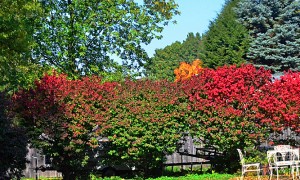Guest Post By Andrea Davis
Now that the winter chill is no longer nipping at your heels, it’s time to assess your landscaping and see what you can do to revitalize it for the spring ahead. It’s imperative that you start working on the lawn now, while you can take advantage of the mild days and hire a landscaping professional (if you need to) before they’re all booked solid through the summer. Here’s what you need to do to get your yard in shape for the season:
1. Due to the harsh winter that hit most of the United States during the early part of the year, there’s a good chance your trees and shrubs were damaged by ice and snow. You’ll need to inspect them for cracks, broken limbs and other problems. Use shears and other tools to get them back in shape — or have them professionally trimmed and pruned, which costs between $200 and $650, depending on the number of trees and shrubs.
 2. Because of the snow, winter climate conditions and seasonality, you will need to rake debris away from the grass. It also helps to control thatch on the lawn. You don’t want a buildup of more than ½ an inch. This also gives you a chance to look for matted areas, which could be a sign of snow mold. Raking the lawn also gives it a chance to breathe again.
2. Because of the snow, winter climate conditions and seasonality, you will need to rake debris away from the grass. It also helps to control thatch on the lawn. You don’t want a buildup of more than ½ an inch. This also gives you a chance to look for matted areas, which could be a sign of snow mold. Raking the lawn also gives it a chance to breathe again.
3. Over time, your lawn might become compacted — especially with a lot of traffic or excess debris. In such cases, you will need to aerate the lawn. You can do this as a DIY project by poking holes in the soil and loosening it up, or you can have a professional aerate the lawn for $50 to $200, depending on square footage.
 4. If you find a lot of matted patches and bare areas in your lawn, it might be time to apply more seeds to fill those neglected spaces. This is known as overseeding and is usually another task recommended in the fall. You can do it in the spring if absolutely necessary though — particularly if you have a lot of bare patches — by applying a nitrogen fertilizer atop the seeds. Then be sure to water and keep an eye on the soil to see if the areas grow. This could be harder to do in hot, humid climates, so consult with a lawn care professional before buying too many supplies.
4. If you find a lot of matted patches and bare areas in your lawn, it might be time to apply more seeds to fill those neglected spaces. This is known as overseeding and is usually another task recommended in the fall. You can do it in the spring if absolutely necessary though — particularly if you have a lot of bare patches — by applying a nitrogen fertilizer atop the seeds. Then be sure to water and keep an eye on the soil to see if the areas grow. This could be harder to do in hot, humid climates, so consult with a lawn care professional before buying too many supplies.
5. To reinvigorate your lawn for spring mowing and gardening, you should add fertilizer. You can use compost or chemical fertilizers, depending on what you think is best, what falls within your in budget and what professionals recommend. It’s recommended that you use less fertilizer in the spring than you would in the fall if you have a cool-season grass. Otherwise, you’ll increase the potential for diseases and weeds. Only apply a light seasoning to help your lawn get some nutrition.
6. Now is also a good time to apply some pre-emergent weed control, which acts as a barrier against weed seedlings. You should do this before applying organic fertilizer and continue to do so through the summer.
7. Regardless of whether you use organic or chemical fertilizers, you should also apply mulch in any flower beds and around trees to help them retain moisture during the early spring months. It also helps to decrease the temperature of plant roots and insulates them should there be an unexpected freeze during the spring. On a visual level, it adds a neat look and separates the bed or tree from the landscape without requiring bricks or rocks. Never apply more than 3 inches of mulch.
8. Before you start mowing the lawn, be sure to sharpen the blades. You can have a professional do this or complete it as a DIY project. If you pursue it as a project, remove the spark plug and then take the blades off. You want to be sure and cut the grass, not tear it. Tearing grass can brown the blades and promote fungus growth.
9. If you have a sprinkler system, now is the time to start inspecting it for any damages and hire a professional to perform repairs. This is also the time to have the system reactivated, which costs between $50 and $100.

10. Now that you’ve performed all the maintenance, repairs and other preparatory measures, think about plants. You’ll want to think about species that are compatible with heat and drought, depending on your environment. If you have perennials that are overgrown in one area, now is a good time to transplant them. The possibilities are nearly endless — it just depends on your budget and time.
If you are planning to sell your home this spring, here are more tips on front yard landscaping for the spring real estate market from Quicken Loans. Just be sure you keep your landscape in top shape, regardless of who it’s for. It saves you money in the short- and long-term, and it looks good too!
Andrea Davis is the editor at HomeAdvisor, which connects homeowners with home improvement professionals in their area for free. Connect with Andrea on Google+







This is some really good information about spring landscaping. I liked that you talked about how it would be good to use fertilizer on your lawn in the spring time. As a new homeowner, I didn’t realize that could be so effective in the spring.